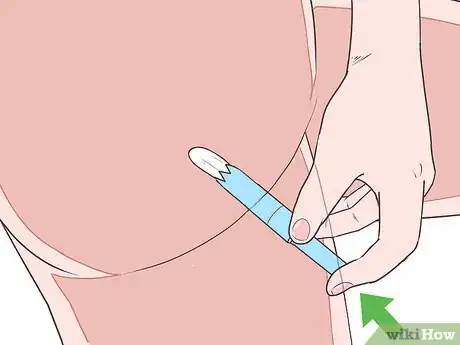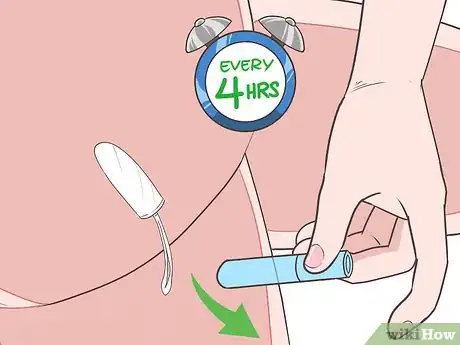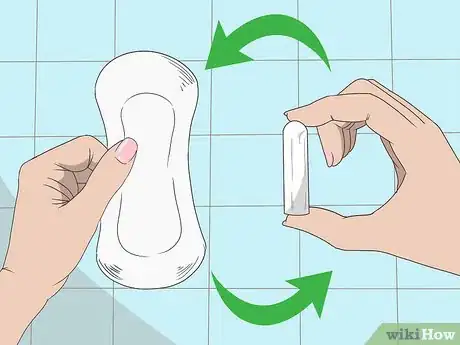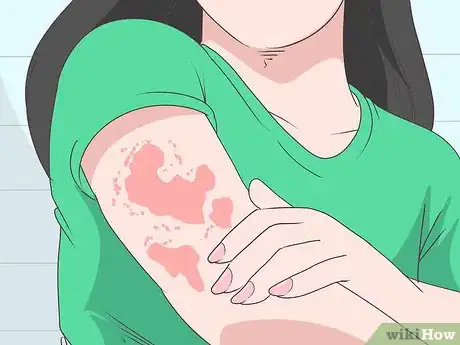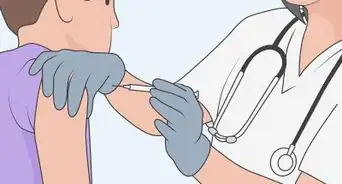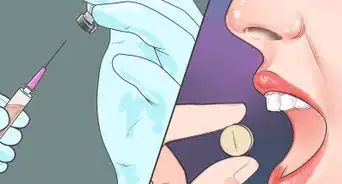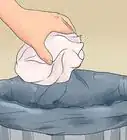This article was medically reviewed by Luba Lee, FNP-BC, MS and by wikiHow staff writer, Jennifer Mueller, JD. Luba Lee, FNP-BC is a Board-Certified Family Nurse Practitioner (FNP) and educator in Tennessee with over a decade of clinical experience. Luba has certifications in Pediatric Advanced Life Support (PALS), Emergency Medicine, Advanced Cardiac Life Support (ACLS), Team Building, and Critical Care Nursing. She received her Master of Science in Nursing (MSN) from the University of Tennessee in 2006.
There are 8 references cited in this article, which can be found at the bottom of the page.
This article has been viewed 87,074 times.
Toxic shock syndrome (TSS) is an illness caused by exposure to one of two types of bacteria – Staphylococcus aureus (staph) and Streptococcus pyogenes (strep). While TSS is rare, it is a serious illness and can be fatal. Incidences of TSS are most often related to the use of tampons, particularly super-absorbent varieties. However, men, women, and children can also get TSS for other reasons. To prevent TSS, practice good hygiene, especially with open wounds, and use tampons and other menstrual products properly.[1]
Steps
Using Menstrual Products Properly
-
1Choose the lowest absorbency necessary for your flow. TSS is associated with super-absorbency tampons. To prevent it, don't use super-absorbency tampons unless they are necessary due to a heavy flow. Even then, you might experiment with using a lower absorbency but changing it more frequently.[2]
- You might also want to use a combination of a lower absorbency tampon with a light pad or panty liner. Panty liners can also help prevent accidents while you're trying to find the lowest absorbency you need.
Tip: Menstrual flow typically isn't consistent throughout your period. Use a lower absorbency on lighter days, but keep some medium and high absorbency tampons around for heavier days.
-
2Insert your tampon gently to avoid scraping the vaginal walls. When inserting your tampon, move slowly and gently. Don't push the tampon any further in your vagina than you need to. Take the same care when removing a tampon – don't just yank it out.[3]
- Take particular care if you use applicator tampons, as they are more likely to scrape when inserted. It can help to put a small amount of lubrication on the applicator before you insert it.
Advertisement -
3Change your tampon every 4 hours. Tampons that are left in your vagina too long may encourage bacteria to grow. This is the biggest way tampon use increases the risk of TSS. However, if you remember to change your tampon every 4 hours, you shouldn't have anything to worry about.[4]
- Consider switching to light pads or panty liners if your flow is extremely light. A dry tampon may stick to the vaginal walls and cause abrasions when removed. These tiny abrasions may then become infected with bacteria that could lead to TSS.
- Since sleeping with a tampon in means leaving it in for 7 hours or more, consider using sanitary pads for sleeping.
-
4Alternate between tampons and sanitary pads. The less you use tampons, the lower your risk of contracting TSS. There may be some situations where tampons are more convenient, or you may feel embarrassed when you wear a pad in public. But if you find ways to use tampons less over the course of your period, you can prevent TSS.[5]
- For example, you might wear tampons while at work or school, and then switch to pads when you get home in the evening.
-
5Store menstrual products away from heat and moisture. Heat and moisture encourage bacterial growth. Instead of storing your tampons in your bathroom, transfer them to a bedroom closet or drawer. Leave them in their original packaging, or transfer to a sealed container.[6]
- Never unwrap a menstrual product of any variety until you are ready to use it. They are packaged to remain sanitary.
-
6Practice the same habits with all menstrual products. Other alternatives to tampons, including menstrual cups, have also been linked to the growth of bacteria that can cause TSS. To avoid this risk, remove anything you place in your vagina every 4 hours and clean it thoroughly before replacing it.[7]
- Organic cotton tampons are not safer than tampons made of mixed cotton and rayon or viscose in terms of preventing TSS. You should still choose the lowest absorbency necessary, and change your tampon every 4 hours.
Maintaining Good Hygiene
-
1Clean and bandage skin wounds. If a cut, burn, or other skin wound gets infected, you could develop TSS. Clean the wound and carefully apply a clean bandage that covers the entire wound. Change the bandage at least once a day.[8]
- Clean the wound gently every time you change the bandage. Inspect the wound for signs of infection, including swelling and redness. Call your doctor immediately if you develop a fever.
Tip: Wash your hands thoroughly before and after cleaning and bandaging a wound. Avoid touching the clean bandage any more than necessary, particularly the part that touches the wound.
-
2Follow instructions carefully when using vaginal contraceptives. Vaginal contraceptives, such as the vaginal sponge, can put you at risk of developing TSS. While you can insert a sponge up to 24 hours before you have sex, try to leave it in as short a time as possible to prevent bacteria growth that can lead to TSS.[9]
- Leave the sponge in place for at least 6 hours after sex, but then remove it as soon as possible after that. Never leave it in for more than 24 hours after sex.
- Throw away vaginal sponges after using them. They are not safe for reuse, even if cleaned.
-
3Bathe or shower daily while menstruating. Hygiene is particularly important while you're menstruating, especially if you're using tampons. Even if you feel sluggish or have cramps, try to at least take a brief shower and clean your thighs and vulva.[10]
- While your vagina is "self-cleaning," the outside of your vagina and your inner thighs are not. Clean gently with warm water and an unscented soap or bath wash each day.
-
4Wash your hands well before and after inserting a tampon. Dirty hands are the most common source of bacteria. Wash your hands thoroughly before and after inserting a tampon. Do not unwrap the tampon until after you've washed your hands.[11]
- Even after washing your hands, only touch as much of the tampon as is necessary to insert it.
- You should also wash your hands in between removing an old tampon and inserting a new one.
Recognizing Signs and Symptoms
-
1Watch for a sudden onset of symptoms. Common symptoms include fever, rash, nausea, and fatigue. TSS symptoms typically come on all at once, rather than evolving slowly. This can be a way to distinguish TSS from more common illnesses, where your condition gradually worsens.[12]
- If you develop a fever and flu-like symptoms while menstruating, remove your tampon immediately and seek medical attention.
Tip: Since TSS is extremely rare, it's far more likely that you have a more common illness. However, TSS is considered a medical emergency. In the event you do have TSS, getting immediate medical treatment could save your life.
-
2Take your temperature if you feel you are running a fever. One of the first signs of TSS is a sudden high fever of 102.2ºF (39ºC) or above. The fever will likely be accompanied by other flu-like symptoms, such as a headache or muscle soreness.[13]
- Having nausea or diarrhea along with a fever may also be a sign that you've contracted TSS.
- These symptoms could be signal a wide variety of illnesses, including a basic cold or flu. However, if you have a high fever, you should seek immediate medical attention regardless. The doctor will take tests to eliminate other possible causes of your illness.
-
3Look for changes in skin coloration, which may look like a rash. A sunburn-like rash over most of your body is a sign of TSS. You may also notice that your lips, tongue, and the whites of your eyes turn bright red.[14]
- After a day or two, the rash will start peeling. This is also somewhat like a sunburn, except that your skin will start peeling in large sheets.
Warnings
- Your risk of developing TSS rises if you have existing staphylococcal bacteria in your vagina and also leave tampons, diaphragms or contraceptive sponges in too long. Additionally, minor trauma, viral infections, surgical procedures, and taking NSAIDs all increase your risk.[15]⧼thumbs_response⧽
- If you've already had TSS, or some other serious staph or strep infection, don't use tampons or vaginal contraceptives, such as diaphragms or sponges.[16]⧼thumbs_response⧽
References
- ↑ https://kidshealth.org/en/teens/tss.html
- ↑ https://my.clevelandclinic.org/health/diseases/15437-toxic-shock-syndrome/prevention
- ↑ https://www.betterhealth.vic.gov.au/health/conditionsandtreatments/toxic-shock-syndrome-tss
- ↑ https://www.betterhealth.vic.gov.au/health/conditionsandtreatments/toxic-shock-syndrome-tss
- ↑ https://my.clevelandclinic.org/health/diseases/15437-toxic-shock-syndrome/prevention
- ↑ https://kidshealth.org/en/teens/tss.html
- ↑ https://consumer.healthday.com/pregnancy-information-29/menstruation-news-473/even-organic-cotton-tampons-can-cause-toxic-shock-study-733153.html
- ↑ https://kidshealth.org/en/teens/tss.html
- ↑ https://www.mayoclinic.org/tests-procedures/contraceptive-sponge/about/pac-20384547
- ↑ https://www.sahealth.sa.gov.au/wps/wcm/connect/public+content/sa+health+internet/health+topics/health+conditions+prevention+and+treatment/infectious+diseases/toxic+shock+syndrome/toxic+shock+syndrome+tss+-+including+symptoms+treatment+and+prevention
- ↑ https://www.betterhealth.vic.gov.au/health/conditionsandtreatments/toxic-shock-syndrome-tss
- ↑ https://kidshealth.org/en/teens/tss.html
- ↑ https://www.nhs.uk/conditions/toxic-shock-syndrome/
- ↑ https://www.nhs.uk/conditions/toxic-shock-syndrome/
- ↑ https://www.merckmanuals.com/professional/infectious-diseases/gram-positive-cocci/toxic-shock-syndrome-tss#v8495482
- ↑ https://kidshealth.org/en/teens/tss.html

